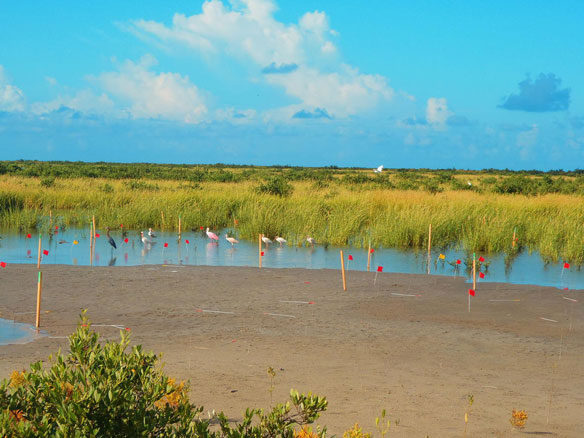
In Port Fourchon, Louisiana, roseate spoonbills and other wading birds feed near color-coded posts marking research plots for the USGS-University of Texas Rio Grande Valley study. Photo: USGS
By USGS;
Changes in rainfall and temperature are predicted to transform wetlands in the Gulf of Mexico and around the world within the century, a new study from the USGS and the University of Texas Rio Grande Valley concludes.
Sea-level rise isn’t the only aspect of climate change expected to affect coastal wetlands: changes in rainfall and temperature are predicted to transform wetlands in the Gulf of Mexico and around the world within the century. These changes will take place regardless of sea-level rise, a new study from the US Geological Survey and the University of Texas Rio Grande Valley concludes.
Such changes are expected to affect the plant communities found in coastal wetlands. For example, some salt marshes are predicted to become mangrove forests, while others could become salty mud flats. These shifts in vegetation could affect the ecological and economic services wetlands provide to the communities that rely on them.
“Coastal wetlands are an invaluable resource,” said Christopher Gabler, a former USGS scientist, currently an assistant professor at the Texas university, and lead author of the study, published January 23 in Nature Climate Change. “They protect surrounding communities from storms and coastal erosion, support fisheries and wildlife, purify water pollution, and help prevent dead zones from forming in the Gulf.”
It’s unknown exactly how these services would be affected as wetlands transform in response to climate change, which has many different facets. Though studies on climate change impacts in wetlands have typically addressed sea-level rise, this research looked at aspects of climate change that have received little attention.
“Most studies have focused on the impact of sea-level rise on coastal wetlands and have excluded the important role of temperature and precipitation,” said Michael Osland, a USGS research ecologist and study co-author. “We know that climate influences how these wetlands look and work, so this study aimed to demonstrate the importance of considering these forces when modeling what coastal wetlands may look like in the future.”
The intensive study relied on field studies at 10 estuaries in five states (Texas, Louisiana, Mississippi, Alabama, and Florida) along the northern Gulf of Mexico. The fieldwork took place in a variety of coastal wetland types, including mangroves, marshes, and salt flats.
The model included the current climatic conditions, which were based on climate observations from the northern Gulf of Mexico for the years 1981 to 2010. The researchers then evaluated how coastal wetlands might be affected by several potential future climates, including temperature increases of 3.6 to 7.2 degrees Fahrenheit (2 to 4 degrees Celsius) by 2100 and a 10% increase or 10% decrease in rainfall from current levels.
“The Gulf of Mexico is one of the best natural laboratories in the world for studying the influence of temperature and precipitation on coastal wetlands,” Osland said. “Coastal wetlands function similarly worldwide, so our results in this region also indicate what the potential future changes could be in other areas with coastal wetlands.”
The predicted changes are likely to change how these wetlands operate, Gabler added. But it’s not all bad news.
“There are going to be winners and losers,” he said. “Some things are going to be better; some are going to be worse. The systems will do things differently, and ‘different’ is a challenge.”
The research paper is available online.
The project was supported by the USGS’s Ecosystems Mission Area and its Climate & Land Use Change Program and the South Central Climate Science Center.









